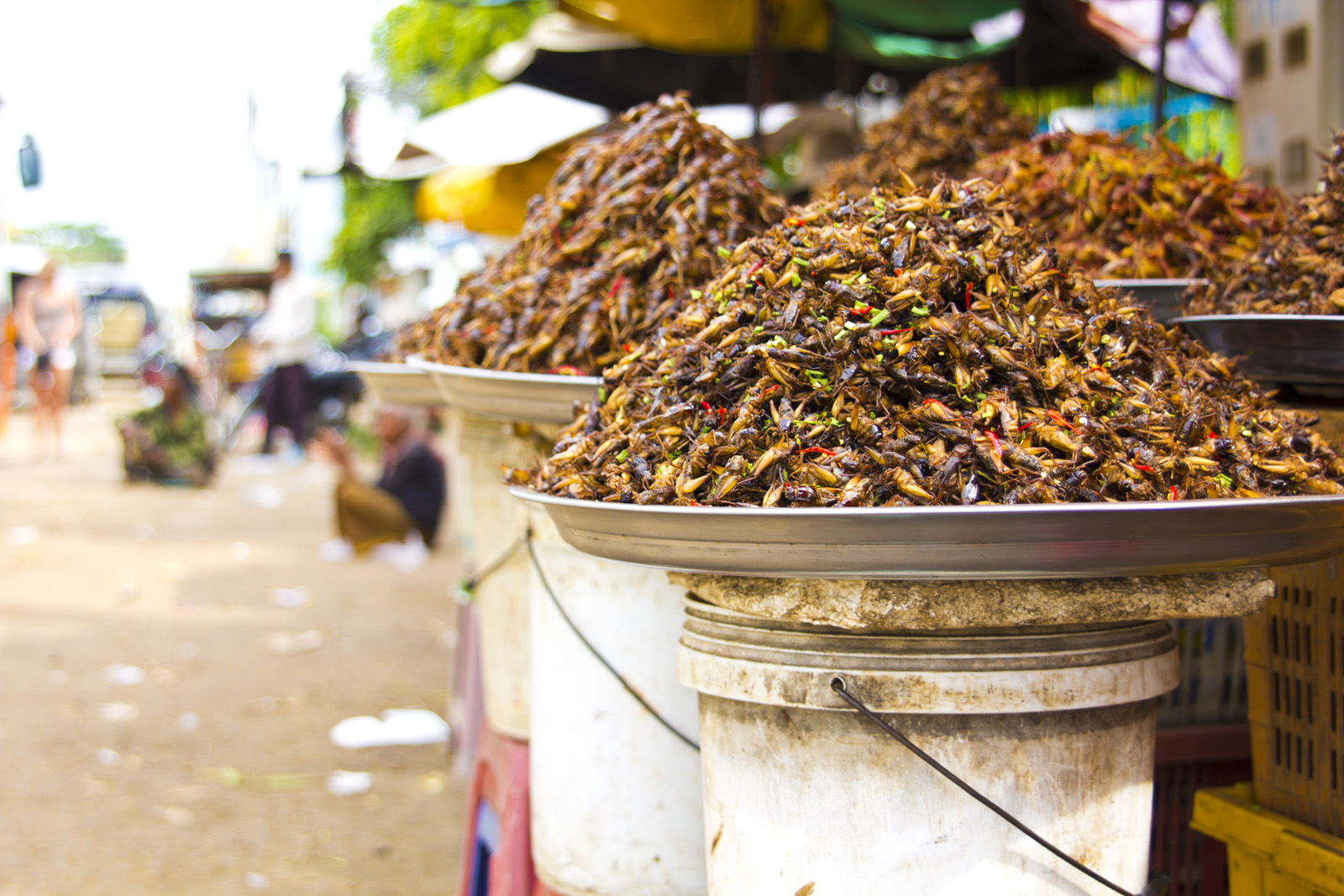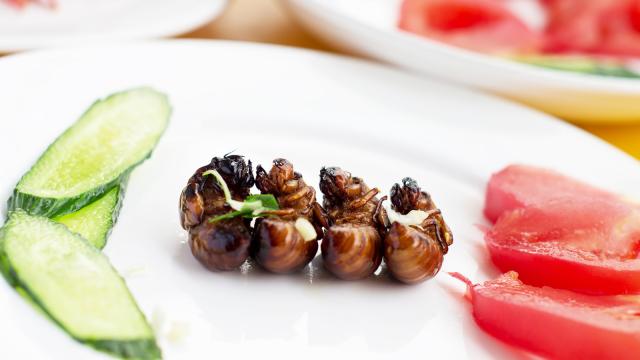Whaddya mean you didn’t chow down on cicada during this year’s mass emergence? You’d be surprised how delicious those little creepy crawlies are with a bit of salt and vinegar. Besides, if you had, you’d have gotten a head start on our inevitable bug-eating future.
With a rapidly growing population already nearing seven billion humans, our current methods of farming large livestock (read: cattle) are simply insufficient to feed us all. Instead, the UN Food and Agriculture Organisation has begun advocating an interesting solution. In an exhaustive report published this past May, the report states, “It is widely accepted that by 2050 the world will host 9 billion people. To accommodate this number, current food production will need to almost double. We need to find new ways of growing food.” That new way is entomophagy, the practice of raising insects as food.
A Ready Precedent
No, don’t scrunch up your nose in disgust. People in 80 per cent of the world’s countries — roughly two billion in all — already eat more than 1400 different species of arthropod. Thirty years ago, Westerners thought sushi was disgusting; before that it was shrimp, and before that oysters. Not only do we love those foods now, they’re considered premium items. So why can’t we get over eating shrimp that just happen to be on land?

Outside of most first-world countries, eating insects is really common, ubiquitous even. Native tribes the world over have been consuming insects for millenia. In fact, coprolite analysis (that’s fossilized feces, by the way) from American and Mexican caves has revealed that our early ancestors routinely consumed a number of insect species — ants, beetle larvae, lice, ticks and mites — well before we attained the technology to hunt or farm.
These ancient traditions are now carried on throughout Latin America, Asia and Africa. North America as well if you count the 90 million kilograms of lobster and 136 million kilograms of crab that are consumed annually in the the US alone. What? If tuna is the chicken of the sea, then crustaceans are its bugs.
What’s Good (And Good For You)
As it turns out, insects aren’t just efficient to raise — pound for pound requiring a quarter the precursor and land as beef — they’re a pretty excellent source of protein and fat as well. One hundred grams of crickets, for instance, contains 12.9g of protein and 5.5g of unsaturated fat. The same portion of grasshoppers has 20.6g of protein and 6g of fat, while that amount of lean sirloin comes with 30.5g of protein and 5.8g of fat.

Opening up your diet to bugs gives you a huge range of options, as well. Giant water beetles are a popular choice in Thailand; a single serving contains nearly 20g of protein, 8.3g of fat, and the insects reportedly emit a delicious smell as they cook. Red ants are also a popular choice, especially dry roasted; a 100g serving includes 13.9 grams of protein and 3.5 grams of fat. That’s half the protein of a serving of Atlantic Salmon (25g) but it’s also less than half the amount of fat (8.13g). On the other end of the dietary scale are caterpillars. These grubs contain up to 55g of protein and 30 grgms of fat per 100 gram serving. That certainly won’t help your diet, but they taste delicious deep fried.
So now that your mouth is undoubtably watering at the prospect, you’re probably wondering where to get some for yourself. But it’s not like you can just jog down to Whole Foods and buy a bag of bugs. Luckily, there are a more than a few farms around the country that are willing to deliver a wriggly mass to your door.
Where to Buy Your Bug Grub
Fluker Farms of Port Allen, Louisiana has been raising crickets for over 50 years. If you’re ordering them for your own consumption, rather than feed your pet lizard, go ahead and pop the delivery box in the freezer once you get it to humanely kill them, and then proceed to clean, de-wing/leg them and prepare. Rainbow Mealworms of Compton, California, on the other hand, raises a variety of meal worms (moth caterpillars) as feed for exotic reptiles, although they are perfectly fit for human consumption.
But what if you want an arthropod-based dish designed specifically for the human palate and you can’t bring yourself to grasshopper genocide? You’ll want to peruse the selection of unique insects from Thailand Unique. The online retailer offers everything from snake whiskey to oven baked tarantula to chocolate covered silkworm pupae. The only problem is that many of the offerings are routinely out of stock.
While dry roasting is a suitable preparation for just about any insect species, certain bugs are best prepared certain ways. If you’re looking for a gourmet meal rather than cricket popcorn, there are several cookbooks available to help you out such as Creepy Crawly Cuisine: The Gourmet Guide to Edible Insects, Entertaining With Insects, or: The Original Guide to Insect Cookery, and Man Eating Bugs: The Art and Science of Eating Insects.

You don’t always have to prepare your own though; bugs have already begun creeping their way into our kitchens. Many forward-thinking chefs, such as Chef Colin King of DC power-lunch destination Oyamel, are beginning to treat terrestrial arthropods in the same manner as their ocean-going cousins. “It’s amazing to me how it’s snowballed,” says David George Gordon, author of The Eat-a-Bug Cookbook, told The Ecologist. “In the last five or six years there’s been a real trend… when I give talks, and ask who in the audience has eaten insects before, I’m amazed how many people raise their hands.”
The one thing you shouldn’t do, however, is just go picking insects from the wild. Some caterpillar species, for example, feed exclusively on nightshade, concentrating the plant’s toxins within its own body and sickening anything that eats it. That’s bad! But beyond that one simple rule, it’s open season on insects. [Time – Wikipedia – LiveScience – The Ecologist – WWF – NYT – Girl Meets Bug]
Pictures: Yaping, kagemusha, Stanislav Komogorov, wonderisland
